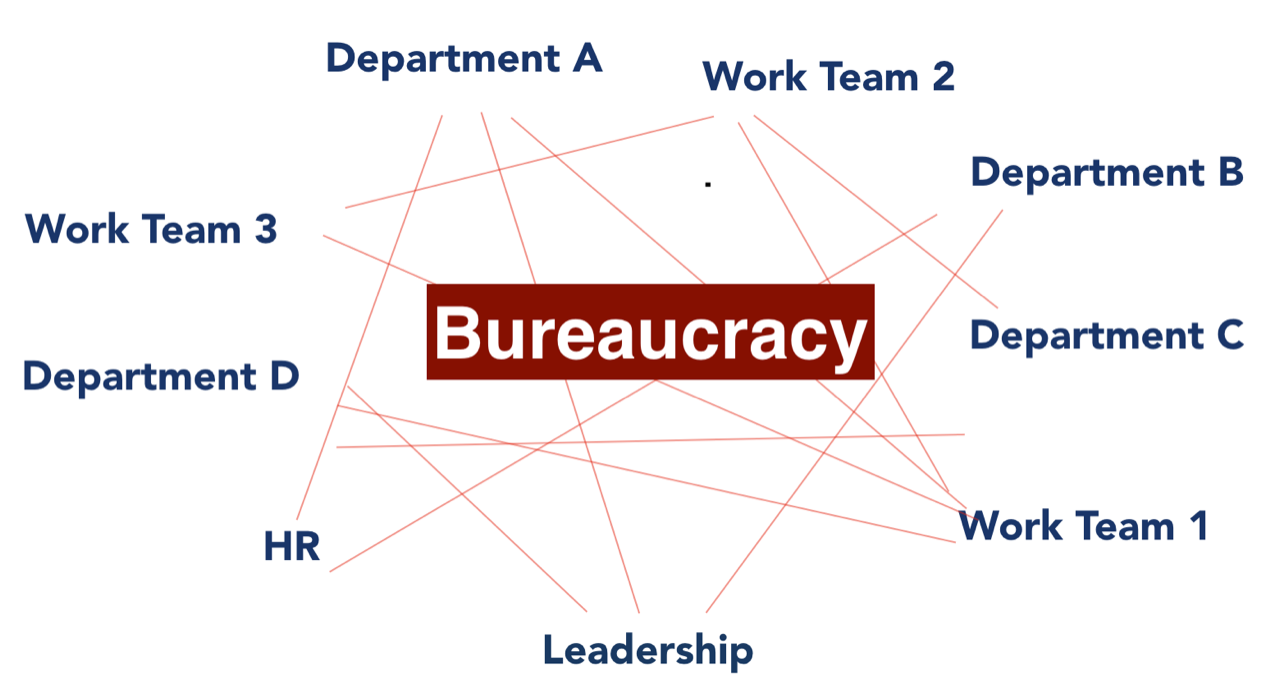Bureaucracy – the Easiest Way to Kill Innovation
Innovation equals change. Change means uncertainty. Uncertainty means fear. The best way to prevent innovation or change is through the implementation of bureaucratic systems. Bureaucratic systems, such as excessive rules, regulations, or reporting, create barriers to change, and these barriers protect the status quo.
For over 30 years the Innovation Engineering team, led by its Founder Doug Hall, has created inventions for the likes of American Express, Coca-Cola, Coors, Diageo, Ford, Hewlett-Packard, Johnson & Johnson, Nike, Pepsi, P&G and many others. During this time, Doug observed that interesting or pioneering ideas would often get strangled by organisations’ bureaucratic procedures, especially if an idea involved new technology. Many people simply don’t like getting their hands dirty to grow ideas, and many organisations optimise for each silo rather than the organisation as a whole.
Systems are defined as two or more independent parts working toward a common aim. In organisations, this means divisions, departments, and/or teams focused on achieving the overall aim of the organisation.
If a good system is defined as “two or more independent parts working toward a common aim” then a bad system is defined as “two or more independent parts working toward separate aims” and Bureaucracy is the technique employed to control a Bad System.

In our experience bad systems come about for one of three reasons; protectionism, overreaction, subversion.
Protectionism: One department seeks to optimise their results/metrics, without thinking through what the impact is on interconnected departments. With innovation, this is often sparked by departments seeking to push work onto other departments. They do this because cost-cutting has reduced their staff such that they can’t handle their existing workload.
Overreaction: A random, negative event has happened and we react by creating more rules and regulations. With innovation this is often the result of a new product, service, or system failure. When a failure occurs, instead of focusing on fixing the root cause, excessive rules, regulations, and inspection is implemented.
Subversion: Someone wants to prevent change from happening. They use a passive aggressive approach of installing rules, regulations and inspection in order to slow down or kill the change. Ego, jealousy, laziness and/or fear are often the root motivation. With innovation this can be caused by “not invented here” syndrome or the feeling that “I’ve got three years to retirement and don’t want to mess up.”
Sadly, once created bureaucratic systems self-multiply. One act of protectionism, overreaction, or subversion creates equal and opposite acts of protectionism, overreaction, or subversion from other departments. Fortunately, there is an antidote. In his most recent book, “Driving Eureka!”, Doug Hall calls it: Bureaucracy Busting – A Four-Step Antidote For Ending Your Suffering.
Step 1: Appreciation for a System – make the system visible to everyone
Step 2: Knowledge about variation – accept that variation will occur and identify areas of high common cause variance.
Step 3: Psychology – identify positive psychological elements that are motivating to those involved in the system versus negative psychological forces which are demotivating.
Step 4: Theory of Knowledge – Having made the system visible and identified areas of variation and negative psychology, we now seek to improve the system. We take an action to reduce variation or remove negative psychology. The method for taking action to improve the system is the same disciplined approach to invent a new product or service and is known as the Deming Cycle. It’s a version of the scientific method that is also known as a Cycle of Learning – Plan, Do, Study, Act or PDSA. The PDSA approach provides a disciplined structure for improving the system and eliminating unnecessary bureaucracy. When we come to resolution with the first learning cycle, we go again with another PDSA cycle and so on.
Steven Brooker, Product Development Manager at Cubis Systems (Europe), a multi-million-pound division of a Global Construction Firm used this approach to create and bring to market a pioneering new product.
He said: “Working at Cubis Systems, we pride ourselves in being innovative by developing and supplying unique ‘Network Access Products’ to the global market. Being part of a large-scale organization, we take pride in leading these markets and we would not be able to sustain our position without addressing the needs of our customers and, crucially, by delivering unique systems to meet their requirements quickly.
“Working within a large and continually expanding company the need for systems, managed in a consistent manner, are a key requirement to success. As we grew exponentially, the demand and requests for new and unique products increased significantly and it became difficult to prioritise and weight these requests, much to the frustration of employees.
“An opportunity for cultural change arose when we gained exposure to Innovation Engineering through our Technical & Product Development director Julia McDaid. Having exposed and conducted this training throughout many areas of the business, we availed of the benefits by using these tools within our Product development projects, which allowed us to address more projects by adopting PDSA cycles.
“Using our Innovation Engineering skills and training, we successfully developed a new and innovative cable management system; ‘PROtrough’. Having delivered this product to the market successfully and quickly, we soon realised the benefits of adopting Innovation Engineering processes for future product development and have now integrated PDSA cycles as part of our approach to new product development. With this in place, we have implemented an open-door approach to idea generation and development across the group as well as a standard and consistent process for taking these ideas and developing them into unique products.”
Innovation Engineering provides a systems-based approach to innovation using online tools and data sources to help companies innovate, improve project speed and performance, and reduce risk. It is all about developing systems that enable rather than control.
Helen Potter

Co-founder and CEO of Potter Innovation






